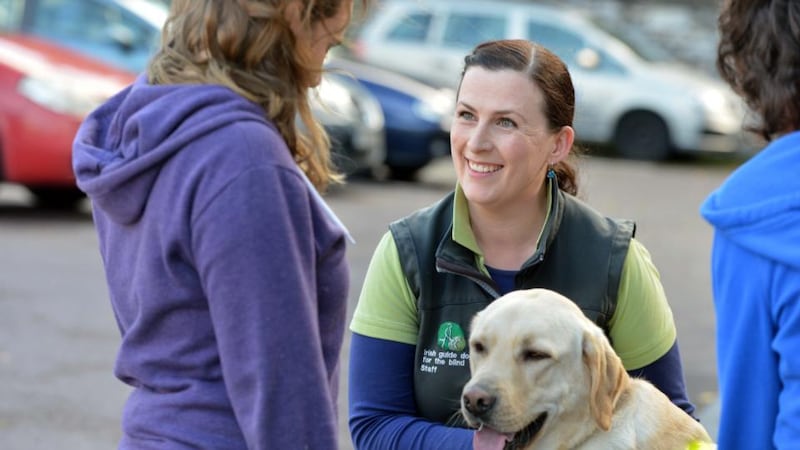As a guide dog mobility instructor with the Irish Guide Dogs for the Blind, my job involves training guide dogs, matching them to clients on our waiting list and training the clients to work with their new guide dogs.
Although I have always loved animals, it was never my intention to become an instructor when I started working as an administrator in client services at the Irish Guide Dogs for the Blind’s headquarters and training centre on the Model Farm Road in Cork eight years ago. In fact, I knew very little about the organisation but I gained an interest pretty quickly after starting there. I began volunteering in the kennels in the evenings and after going out with some of the other trainers, I decided this was what I would like to do.
When a one-year apprenticeship came up for the Early Training Unit, where the dogs go for their initial training, I applied for it and after working as a trainer for a year, I did an apprenticeship for an instructor in the Advanced Training Unit.

Dogs are as different from each other as people
As instructors we work in cycles. We spend 12 weeks training the dogs in advanced skills and matching them with clients, which is a very complex process because dogs, like people, are very different from each other. After the dogs complete their advanced training, the clients come to stay at our residential centre, where we train them to work with the dogs.
They go home with their new guide dogs, and we go to the client’s home for two weeks of post-class training. We return six weeks later to check that all is going well, then six months later and then yearly. We are always available on the phone as well to deal with any problems that come up.
I’m training four dogs at the moment. Nico is half Labrador and half golden retriever; he is a lovely placid dog while brothers Milo and Merlin are real livewires. Kili, who is half retriever and half German Shepherd, is very sweet and much more reserved than the boys.
Guide dogs must be willing to please
We breed all our own dogs and they stay with our puppy volunteers or foster parents for the first 12 months of their lives once they have been vaccinated and microchipped.
They then go into the Early Training Unit where they are trained to a certain level before moving on to the Advanced Unit where their skills are developed and consolidated.
We have to decide whether a dog would be more suitable as a guide dog for visually impaired people, or an assistance dog for children with autism. A guide dog needs to be very obedient and willing to please but must also be confident and have the ability to make decisions and deal with pressure. Assistance dogs, on the other hand, need to be obedient and very tolerant with children.
I work only with guide dogs and am currently in the 12-week training period, so every morning I collect my dogs from the kennels, load them into the van and head out. I spend the first couple of weeks getting to know the dogs and their personalities, their strengths and weaknesses. By about the fourth week, I start looking at clients on the list who might be potential matches, but I don’t want to make a decision too early.
It’s not generally the next person on the waiting list who gets the next dog. There are so many details to be taken into account, from the client’s age, occupation, location, daily routine, handling ability, and even their voice, to the dog’s size, walking speed, ability and temperament.
We test the dog’s skills in a variety of settings from busy city centres and office blocks to quiet country lanes and rural towns.
Once we have matched the dog to the client, we will tailor their training so that they are tested in the type of environment they will be working in. We take them on buses and trains, and there are working dogs in schools, universities and office blocks around the country.
Bonding from trainer to owner After lunch, we go back out in the van or I set up an obstacle course in the centre for them. Sometimes, I do blindfold walks with them.
Once the dogs are finished their advanced training, the clients come to the centre for three weeks of residential classes. Three weeks might seem like a long time, but working with a visually impaired client means a big jump in responsibility for the dog and it also takes time to transfer the bond from me to their new owner.
The classes are very structured and cover everything from obedience, learning to read the dog’s movements, positions and commands to play sessions and relaxation. The clients have to learn what the dogs are capable and not capable of. At the end of the day, they are not Lassie; it is very much a partnership.
During class, we leave the centre with the clients and their dogs and do lots of outdoor training – for example, going into town on a bus if that will be part of the client’s normal routine. A guide dog has full access rights when working with a person with a disability, apart from some exceptions such as the Zoo or isolation areas in a hospital.
After they go home, I visit the client’s home for the post-class training. There are often teething issues settling in; everything is so structured here, and there tends to be less consistency at home.
Positive life change When I am on the road doing home visits, I stay in hotels and get to visit all sorts of different places. I enjoy the variety this brings to the job. I spend another two weeks on the road providing routine aftercare to existing clients, checking in to see if they have any concerns and if they and the dogs are doing okay
.
Sometimes, we might need to prepare a dog for retirement, or sometimes a refresher course in obedience or assistance with a new route might be needed.
The most rewarding part of the job for me is seeing a dog settling into their new home with a guide-dog owner. I get very attached to my dogs and it can be hard to let them go, but that’s what we work towards. It’s all worth it when I go out and see a dog working and making a positive change to somebody’s life.
The feedback from the clients is hugely positive, and the majority say they would never go back. As well as the independence and mobility they give to their owners, the dogs provide companionship and love. On the other side, there is a lot of care and cost involved, so they are not for everybody.
My own dog, Punch, a retired guide dog, is a real character. I took him home for a weekend six years ago and I still have him. He comes to work with me quite a lot and sits in the client services office waiting for me.










